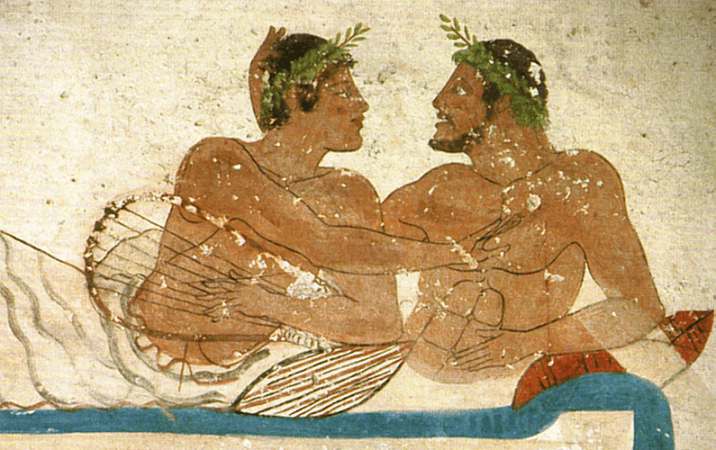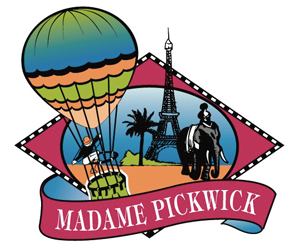MY BIG FAT GREEK WALL FRESCO
Suppose all we knew about Shakespeare was that his Elizabethan contemporaries had considered him their greatest playwright. Then supose that, against all odds, a copy of one of his plays turned up. The excitement of such an event would create can only be imagined.
Similar excitement was generated by the discovery, outside Paestum in southern Italy, of frescoes painted by Greek artists at a time when Greek civilization was at its height; the such paintings ever seen by modern man.

www.mlahanas.de ''A closer look at the pair of two men in love? Or does the young man with the Lyre say “NO” by stretching his hand?''
The world has aleays, of course, possessed evidence of the artistic genius of ancient Greece. In architecture, one thinks of trhe Parthenon in Athens, or the temples of Paestum. Greek sculpture is exhibited in museums everywhere. So is Greek pottery. But until relatively recent times, almost no examples had been found of Greek wall-painting, which the Greeks of old considered the noblest expression of their culture. What had happened to their paintings? It was assumed they had all been destroyed in antiquity or obliterated by fire, time, or weather. And since the ancient Greeks did not bury their dead in tombs, archaeologists had concluded that their chances of finding and Greek wall-paintings were virtually nil.

''What does the Symposium in the diver Tomb represent? A life, with wine, wife (or man) and song, as it was or as it will be?''
To inderstand how this conclusion was upset, it is helpful to know something about when and where the newly found paintings were executed, and by whom. In about 720 B.C. Greek mariners founded a settlement called Sybaris on the gulf of Taranto. Sybaris became the first of several cities in a prosperous Greek colony, extending over eastern Sicily and southern Italy, known as Magna Graecia. Its citizens’ love of luxury was such that to this day the word ”sybarite” means a person devoted to luxury and pleasure.
Like other cities of Magna Graecia, Sybaris traded with the Etruscans to the north. In about 650 B.C. a group of Sybarites founded a city called Poseidonia on the Gulf of Salerno. This city was to remain completely Greek; historically, traditionally, culturally,, for more than two centuries, until, in the fifth century B.C. , it fell to the neighboring Lucanians, Italic tribesmen from the mountains of the nearby interior, ruled Paestum until 273 B.C. , when the city fell under Roman domination.
So much for the strict historical background. In 1967, at the behest of the Italian government’s office of Antiquities in Salerno, excavations began on the necropolises outside Paestum. The results yielded were electrifying and beyond expectation: a tomb dating from early in the fifth century B.C. , the stone slab walls of which were covered with frescoes. These wall paintings were unmistakably Greek, and the tomb that they decorated soon became known, after the view of a diving man on one of its panels, as the Diver’s Tomb

jonkstuff.blogspot.com ''There was a school of cartooning started by Johnny Hart in the late 50s that I think of as "Rat Pack" cartoons. They have the sensibility of jaded hard-drinking street-raised misogynists - the way men used to be when left to our genetic makeup - before hippies came along and taught us to pretend to be sensitive. Like Sinatra and his pals, Johnny Hart's characters innocently refer to the girls as "broads". Is that still allowed?''
Hardly less exciting was another find in a year later of a necropolis from the second half of the fourth century B.C. Almost half of its tombs were formed by stone slabs; they contained not only painted vases, figured terra-cottas, gold and silver jewels, and incised precious stones but also, and herein lies the originality of the find: approximately two hundred slabs covered with frescoes. Thus, two successive finds added two new chapters to the history of ancient Greek culture in its two main stages, Classical and Hellenistic.
The painting slabs in the Divers Tomb has been dated with confidence to about 500 B.C. This dating is based on objects in the tomb and on such stylistic details as the manner of rendering eyes and abdominal muscles and the forms of the vases shown. The paintings resemble, moreover, those on pottery of the same period.

jonkstuff.blogspot.com ''I can't figure out how these cartoons ever made it into the funny papers. They are so anti-family safe. They're cynical, somewhat clever (compared to most daily comics that talk down to you) and they strip away the phony veneer of polite behavior to reveal our true ugly stuffed-with-guts interiors.''
So the Diver’s Tomb frescoes were painted at a time when Paestum was completely Greek. In 480 B.C. the so called Temple of Ceres had just been finished, and the so called Temple of Neptune, the most Greek of all Greek monuments, had not yet been built. Clearly, no art could then have flourished in Paestum that was not essentially Greek.
A closer look at the Diver’s Tomb frescoes serve to dispel any lingering doubts of their Greek origin. Their leading characteristic is their total compositional balance. Individual figures are, moreover, imbued with monumentality. All this is Greek and only Greek. Then, too, the draftsmanship is so sure, and the detachment of the figures from the background so deftly done, that these frescoes could only be the expression of an art that had attained a very high level.

''The inside of the lid of the tomb, a man diving into the water from a tall structure. What does it represent? The diving into the world of the dead (into the Okeanos)? Another interpretation is that the columns represent the Pillars of Hercules as a symbol of the end of the world maybe a symbol of the end of life''
But let us suppose for a moment that these paintings were not Greek. What other art could have produced them? Etruscan painting is a possibility, but a comparison of the Diver’s Tomb frescoes with the finest Etruscan paintings reveals some substantial differences. The drawings underlying Etruscan paintings is slighter, more nervous, and very often less accurate, while the figures, though full of movement, lack monumentality. In Etruscan painting moreover, the composition tends to be diffuse and fragmented, with none of the coherence and strict unity that characterize the Greek artistic vision, and the paintings of the Diver’s Tomb.
At first glance these frescoes may appear Etruscan from their subjects. In the Diver’s Tomb a funeral banquet is shown with guests reclining on tricliniums, intent on love play and music. The theme, is indeed, common in Etruscan painting. Looking closer, however,, there are substantial differences. The banquet guests are male lovers, which is typically Greek, whereas in Etruscan paintings the encounters are always between persons of opposite sexes.
The conclusions to be drawn from the Diver’s Tomb frescoes are clear, but the paintings discovered in the second wave two lears later are another matter. These all date from between 320 and 340 B.C. In them are hunting scens, bloody fights between foot soldiers, chariot races, mounted horsemen, flautists, weeping women, flowered garlands and wreaths, boxing matches, mules pulling little chariots, and numerous satirical and comic scenes.

The wall paintings of the so-called Lacanian era, done at the very start of the Hellenistic age, are a blend of classical Greek and livelier, less formal local styles
These paintings are classified as Lucanian, but this simply means they were painted when Paestum was under Lucanian rule. The question remains: were they produced by a culture that was still Greek or by one that could be called Lucanian ? That has to be responded to with caution, since these pictures display a wide variety of artistic approaches. In some, the artist is repeating themes from earlier times and could therefore be called a traditionalist; in others, new features appear, such as depth, the sense of space, and a rapid an convulsive movement of the scene. These new features are characteristic of Greek art of the second half of the fouth century B.C. , so whoever painted these pictures could be called a modernist.

''But back to the uglier, less generic, more entertaining expressions of human feeling. No one else drew distasteful ugly human emotions in comics. (maybe once in a while, on a milder level, Charles Schultz did) How the heck did Hart ever sell the first strip??''
In some of the paintings the artist is obviously unsophisticated, but is striving to imitate Greek models. Though not a Greek himself, he is trying to paint in accordance with a Greek lesson, which he has however, learned very badly. Certain other paintings are ”ungrammatical”, primitive but amusing, and whoever painted these slabs was not only not a Greek but also quite unaware of Greek artistic culture.

jonkstuff.blogspot.com''The characters in B.C. are almost all the same character design, but they have individual personalities (except B.C. himself, who is the prototype middle of the road caveman that all the others are variations of).''
So those paintings from the fourth century B.C. that are customarily called Lucanian are, indeed, in part Lucanian, that is, crude and ingenious; but they are also in part, Greek. Painted in the very years when Alexander the Great was carving out his Eastern empire, the vividly reveal the heightened use of color, the looser composition, and the exploratory mixing of styles that were to characterize Hellenistic art.




Thanks so much for reading. Have written a few times on the artistic traditions of the Eastern Orthodox or what was termed the culture of Byzantium. You have a nice site and I wish you success with it.